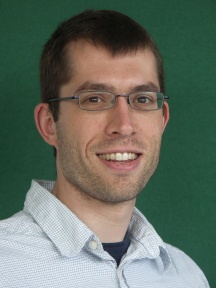In the fall of 2001, an exchange student from Germany arrived at the University of Oregon expecting to stay a year, with particle physics not very high on his list of career priorities. But a graduate level particle physics class and an ensuing summer project on Higgs branching ratios changed all that.
Impressed by Jan Strube’s performance, James Brau, professor of physics at the university, recruited his student to join his research group, which was part of the BaBar experiment at SLAC, one of the leading university groups in detector research and development in the United States. It was a small step on a much longer path that would eventually lead to the International Linear Collider.
After finishing the class requirements for his Ph.D. at Oregon, Strube moved to the San Francisco Bay Area to study a rare decay of a type of B meson that was being detected in the debris of electron-positron collisions, at the PEP-II collider at SLAC.
At the time, the much sought-after Higgs particle hadn’t been detected – indeed, CERN’s Large Hadron Collider had not yet been turned on. Yet the ILC was anything but a distant dream. Although the ‘international’ part of the name was not yet in vogue and the technical design was far from finalised, there was still considerable urgency to build the machine. Strube remembers working with a post-doc at Oregon at the time, who hoped to be working on the ILC as early as 2005.
“I had originally expected to start working on the ILC after graduation right away,” Strube recounts.
RUTHERFORD APPLETON LAB
But in late 2007, just when he was finishing his Ph.D. the powers that be pulled the plug on funding for high-energy physics in the United States. Shortly after, equally severe cuts were announced in the UK. Since national projects were under threat, plans for the International Linear Collider could not be entertained.
Strube had already accepted a postdoc position at Rutherford Appleton Laboratory in the UK, but he was shielded from the consequences. His postdoc position survived because it was research on the LHC ATLAS experiment as well as detector development for the ILC. Only the ILC component was slashed.
Strube recounts the grim milieu shortly after the UK announcement. UK particle physicists working on the ILC had to remold their work as generic research and development. Unable to use ‘ILC’, or even the word ‘Linear’ in the project title, they used names such as ‘Generic Lepton Collider’ or ‘Generic Future Accelerator’. It was the only way to save their projects.
Meanwhile, high-energy physics budgets in other countries seemed resilient, and international conferences for the ILC continued to occur. Despite financial difficulties, Strube and his supervisor Marcel Stanitzki managed to forage funds to take part in the important detector validation process. In 2008 they attended the SiD(Silicon Detector) workshop at Boulder, Colorado by sharing hotel rooms. At the conference, physicists working on ILC detectors worldwide prepared to narrow down the four ILC detector concepts to the two most viable ones. In that same year, they also attended the Linear Collider Workshop in Chicago.
Still, Strube had low expectations about future work on the ILC. ATLAS was still a safer bet for a postdoc, in spite of the technological glitch temporarily delaying the LHC from starting operation in 2008. During the short downtime, Strube witnessed two ILC research and development programs being approved for funding at Rutherford Appleton, and then cut at the last moment. They were frustrating times, for Strube and linear collider R&D.
CERN
Despite this, Strube wasn’t entirely isolated from the ILC. In 2008 he also joined the newly formed linear collider detector group at CERN, which started off using ILC detector designs and ILC software, tweaking them for the CLIC environment. In 2010, Strube ended up as one of the chapter editors for the CLIC’s Conceptual Design Report which was still being compiled. In 2011, he accepted a fellowship at CERN to work on the CLIC.
“All the other fellowship offers I had were purely LHC projects,” Strube said. “CLIC wasn’t the ILC, but it was another linear collider and there was considerable overlap.”
There was substantial synergy between the CLIC and the two working ILC detector groups despite them being competing projects.
Once Japan became the leading contender for hosting the ILC project, it was natural for Strube to return to what he’d dreamed of doing as a graduate student.
WORKING IN JAPAN
Strube had married a Japanese girl whom he met as an exchange student, so the prospect of more permanency in Japan was always in the picture. He accepted a full-time position at Tohoku University starting early 2014, where he teaches the physics of B meson factories. Tohoku is also the designated site for ILC construction.
When he isn’t overseeing graduate students working towards their Ph.D., Strube is the deputy liaison for Hitoshi Yamamoto—associate director for physics and detectors in the Linear Collider Collaboration— for detector research and development.
Strube helps Yamamoto keep a detailed census of all detector research groups – what projects each is working on, their manpower, the future course each group expects to take and their funding scenarios. Strube helps document how each group will be able to contribute to the ILC project when the time comes. He helps create a detailed survey of the field.
Strube was pleasantly surprised by the breadth of projects Japanese ILC scientists were involved with. He expected to find mainly simulation studies and theorists playing with models. But he found that his colleagues at Tohoku were also highly involved with infrastructural planning.
Associate professors at Tohoku were already active in industrial and economic forums and keeping local government officials informed. The amount of local support was evident from the signs made by the local community and a big showcase depicting the ILC at the Ichinoseki train station. A detailed plan of the ILC campus is currently being developed so that foreigners can live and work comfortably, even though the project hasn’t officially been approved. Recently, both detector groups scouted the point where the two beams will interact from a civil engineering standpoint, to gauge how to get the necessary parts there and if bridges en route are equipped to handle the weights.
“The Japanese like to have everything in place when they make an announcement,” Strube said. “When they say something, they know it works.”
These days Strube runs a blog cataloging life in Japan, the cultural differences foreigners are likely to face, the practical barriers they need to prepare for, as well as his thoughts on particle physics. He hopes it will be of use to other particle physicists moving to Japan. Hopefully, they’ll be ILC physicists.



Recent Comments